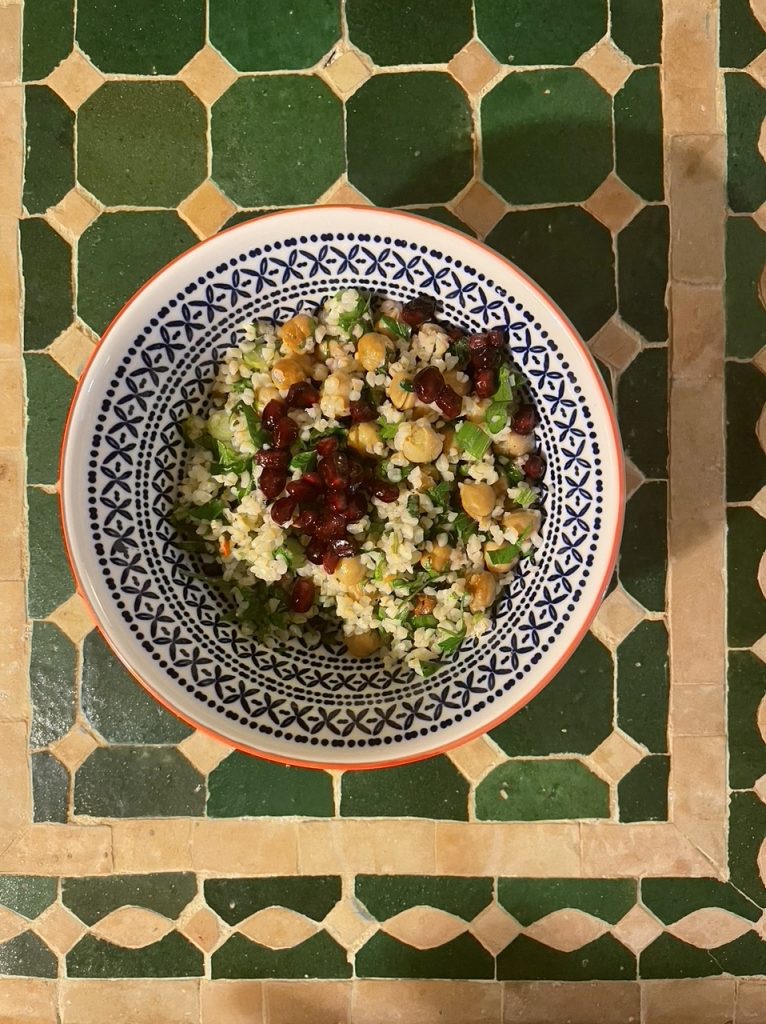Middle Eastern cuisine and flavors have a great deal of diversity across many countries, but there are also classic dishes that appear throughout the region. This bulgur salad can be considered a variation of the classic tabouleh, a parsley-based salad with bulgur and tomatoes. Here, we use whole grain bulgur but pair it with classic Palestinian ingredients including chickpeas, mint, parsley, pomegranates, and olive oil [i].
Ingredient Highlights
Whole grains: Whole grains, like whole grain bulgur wheat, have consistently been shown to decrease the risk of chronic diseases such as certain types of cancer, type 2 diabetes, and cardiovascular disease. This has largely been attributed to their dietary fiber content. They are also rich sources of phytochemicals [ii]. Whole grains are recommended as part of a healthy diet in the Dietary Guidelines for Americans [iii].
Chickpeas: The Dietary Guidelines for Americans advocates for increased vegetable and nutrient-dense foods. Chickpeas help satisfy both of these recommendations with their high levels of protein, vitamins, and fiber [iv].
Alliums: Alliums, here in the form of garlic and scallions, are rich in flavonoids, which have been demonstrated to have antioxidant, anticancer, anti-diabetic, cardioprotective, and neuroprotective activities [v].
Pomegranate: Pomegranates have been shown to have health benefits relating to their antioxidant and anti-inflammatory properties. They have particular benefits related to diabetes, cardiovascular disease, and metabolic syndrome [vi].
Recipe
Palestinian Bulgur Salad
Adapted from Yasmin Khan’s recipe in her cookbook Zaitoun.
Serves: 1-2

Ingredients
- ½ cup whole grain bulgur
- 1 cup canned chickpeas, drained and rinsed in water
- 3 Tablespoons olive oil, divided
- Sea salt
- Chili flakes
- 15 grams parsley leaves, chopped (approximately 2 Tbsp)
- 15 grams mint leaves, chopped (approximately 2 Tbsp)
- 1 scallion, thinly sliced
- 1 clove garlic, minced
- 1 lemon, juiced
- Pepper
- Pomegranate seeds, to taste

Instructions
- Preheat oven to 425 degrees.
- Cook the bulgur on the stovetop with ¼ teaspoon of salt in a pot of boiling water for approximately 10 minutes. Generally, you will use a 3:1 ratio of water to bulgur but you can follow the package instructions. Drain, rinse with cold water, and place in mixing bowl.
- Spread chickpeas onto a small roasting pan or baking sheet and toss with 1 Tablespoon of olive oil. Sprinkle lightly with a pinch of salt and chili flakes and place in the heated oven. Roast for 15-20 minutes or until lightly browned. Check after 10 minutes and toss to make sure they are cooked evenly.
- Add chickpeas, herbs, scallions, and garlic to the bulgur and stir to combine.
- Dress with the remaining olive oil, lemon juice, and pinch of salt and pepper, to taste.
- Just before serving, sprinkle with pomegranate seeds. This is to prevent the grains from being stained in red. You can refrigerate the salad for later and add the pomegranates when you are ready to serve.
References:
[i] Ross, Fiona. “Palestinian Territories.” Food Cultures of the World Encyclopedia, edited by Ken Albala, vol. 1: Africa and the Middle East, Greenwood, 2011, pp. 285-296. Gale eBooks, link.gale.com/apps/doc/CX1513300045/GVRL?u=lehman_main&sid=bookmark-GVRL&xid=ce76bfe1. Accessed 9 Dec. 2021.
[ii] Zhu Y, Sang S. Phytochemicals in whole grain wheat and their health-promoting effects. Mol Nutr Food Res. 2017 Jul;61(7). doi: 10.1002/mnfr.201600852. Epub 2017 Mar 17. PMID: 28155258.
[iii] Dietary Guidelines for Americans. https://www.dietaryguidelines.gov/sites/default/files/2020-12/DGA_2020-2025_StartSimple_withMyPlate_English_color.pdf
[iv] Rachwa-Rosiak D, Nebesny E, Budryn G. Chickpeas—composition, nutritional value, health benefits, application to bread and snacks: a review. Crit Rev Food Sci Nutr. 2015;55(8):1137-45. doi: 10.1080/10408398.2012.687418. PMID: 24915347.
[v] Kothari, Damini, et al. “Allium Flavonols: Health Benefits, Molecular Targets, and Bioavailability.” Antioxidants, vol. 9, no. 9, Sept. 2020, pp. 1dn+. Gale Academic OneFile, link.gale.com/apps/doc/A646516044/AONE?u=columbiau&sid=summon&xid=3a55ed6. Accessed 28 Nov. 2021.
[vi] Danesi F, Ferguson LR. Could Pomegranate Juice Help in the Control of Inflammatory Diseases? Nutrients. 2017 Aug 30;9(9):958. doi: 10.3390/nu9090958. PMID: 28867799; PMCID: PMC5622718.
